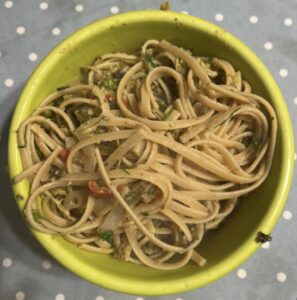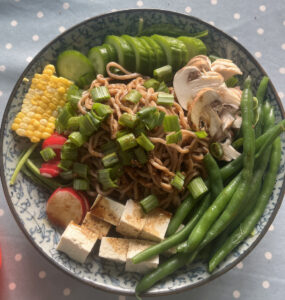Cooking food from countries affected by the travel ban gave me a wonderful feeling of inner peace–both as a private person with people of all nationalities who love to cook and eat good food, and as someone who tries to contribute a little bit to more compassion in the kitchen. Imagine my joy, therefore, when I heard about Kifah Duski’s new book Peace in the Kitchen, which features vegan Arab cooking.
Kifah is originally from the village of Faradis, which is very close to where my parents live; she moved to Tel Aviv for university and, from there, to Prague, where she currently lives. The book is divided into three parts, each for each transition in her life. The Faradis recipes are homey, the Tel Aviv recipes are quick and appropriate for a student kitchen, and the Prague recipes a bit more elaborate and haute-cuisine-ish.
Some of the recipes are not new to me, as I’ve been cooking Middle Eastern food for a long time. But some are completely new, and some feature new forms to make stuff I’ve been making forever. For example, Kifah’s version of shakshuka doesn’t feature thin tofu slices (which is how I’ve been making it) but “egg whites” made of soy and “egg yolks” made of chickpea flour, all layered to look like real eggs.
The book is written in both Hebrew and Arabic. I really wish it came in an English version, because many of my non-Middle-Eastern friends will find stuff there that will dramatically expand their horizons beyond what’s served here in Arab restaurants.
The most impressive recipe in the book, for me, is the labaneh, because I’ve been craving this sour, fermented soft cheese for a very long time. Here it is, in its vegan splendor:
1 cup blanched almonds, soaked overnight
1/2 cup raw cashews, soaked overnight
1/2 cup soy beans, soaked overnight
1/4 cup olive oil
juice from 2 large lemons
water
salt
Place all ingredients except water and salt in food processor and process. Gradually add water until achieving the desired consistency (I like it kind of robust, like fromage blanc) and salt to taste. The original recipe calls for refrigeration, but I left my batch out of the fridge for the night to culture, and it greatly improved its taste and resemblance to the dairy original. Serve with a sprinkle of za’atar.





No comment yet, add your voice below!